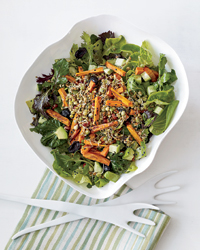Friends dabbling with the raw-food diet have told me about the health benefits of eating sprouted nuts, beans and grains, saying that the process of soaking these seeds (they’re all technically seeds) “awakens their life force” as they begin to germinate. The concept always seemed a little New Agey to me, but after noticing sprouted foods for sale at places like Whole Foods—everything from sprouted brown rice to sprouted tortilla chips—I decided to learn more.
I reached out to Esha Ray, who sells a line of sprouted grains and lentils called TruRoots at health-food stores, and even in three-pound bags at Costco. “I grew up in India, where cooks often sprout legumes before cooking to make them easier to digest,” she says. During the sprouting process, to nourish the tiny shoot as it grows, the complex carbohydrates in seeds break down into simple sugars, and the proteins break down into amino acids; both are easier for the body to process. Sprouted foods also cook more quickly: TruRoots’s sprouted, dehydrated lentils, for instance, need just five minutes in a pot of boiling water.
“Sprouting also changes the chemistry of seeds, so they become nutritional powerhouses,” says chef Adina Niemerow, an expert in holistic cooking. The seeds develop more vitamins (usually lots of A, B and C) and other nutrients, often in concentrated form. Compared to broccoli, for instance, broccoli sprouts can have up to 50 times more of the cancer-preventing phytochemical sulforaphane. Raw sprouts also have lots of enzymes—those mysterious “life forces.” Niemerow believes these enzymes can make you feel younger and more energized.
She is such a proponent of eating raw sprouts, in fact, that she added a section to the second edition of her book Super Cleanse, which comes out this month, explaining how to sprout seeds at home. She recommends buying organic seeds specifically intended for sprouting, sold at some health food stores and on websites like sproutpeople.org.
I’ve found another reason to start a home sprout experiment: “They’re such a sustainable food source,” Niemerow says. It’s an argument that speaks to the locavore in me: Even in the dead of winter, I can have my own sprout garden in a jar under the kitchen sink.
Editor’s note: Raw sprouts present a very small risk of food poisoning, so doctors often advise those with compromised immune systems to avoid them.

Sprouted and dehydrated so they’re shelf-stable, TruRoots’s grains and beans cook quickly in less than half the usual time. $5.50 for one 14-oz bag sprouted green lentils (at stores) or $26 for six 14-oz bags; truroots.com.
Made from sprouted wheat, quinoa and other whole grains, these flours have more vitamins than regular whole-grain flour, but taste the same. $6 for a 32-oz bag of sprouted wheat flour; organicsproutedflour.net.
Sprouted seeds—like flax, daikon radish, chia and broccoli—make these sturdy stone-ground-corn tortilla chips super-crunchy and and a good source of omega-3 fatty acids. $3.50 for a 5.5-oz bag; gowaybetter.com.
This precooked rice comes in a single serving as part of the Rice Express line or with seaweed in a make-your-own sushi kit called Sushi Wraps. $3 for 6 oz; anniechun.com.

Sprouting beans (like the ones featured in the salad here) is easy and makes them super-nutritious. Photo © Antonis Achilleos.
No comments:
Post a Comment